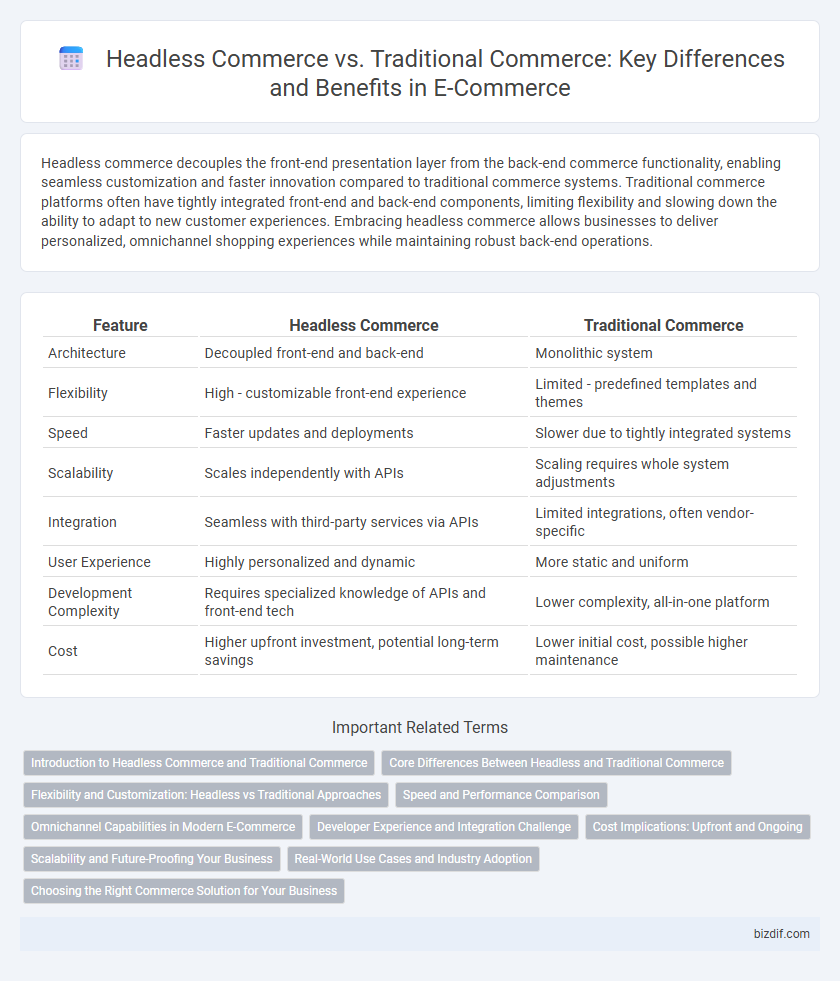Headless commerce decouples the front-end presentation layer from the back-end commerce functionality, enabling seamless customization and faster innovation compared to traditional commerce systems. Traditional commerce platforms often have tightly integrated front-end and back-end components, limiting flexibility and slowing down the ability to adapt to new customer experiences. Embracing headless commerce allows businesses to deliver personalized, omnichannel shopping experiences while maintaining robust back-end operations.
Table of Comparison
| Feature | Headless Commerce | Traditional Commerce |
|---|---|---|
| Architecture | Decoupled front-end and back-end | Monolithic system |
| Flexibility | High - customizable front-end experience | Limited - predefined templates and themes |
| Speed | Faster updates and deployments | Slower due to tightly integrated systems |
| Scalability | Scales independently with APIs | Scaling requires whole system adjustments |
| Integration | Seamless with third-party services via APIs | Limited integrations, often vendor-specific |
| User Experience | Highly personalized and dynamic | More static and uniform |
| Development Complexity | Requires specialized knowledge of APIs and front-end tech | Lower complexity, all-in-one platform |
| Cost | Higher upfront investment, potential long-term savings | Lower initial cost, possible higher maintenance |
Introduction to Headless Commerce and Traditional Commerce
Headless commerce separates the front-end user experience from the back-end e-commerce functionality, enabling businesses to customize and deliver content seamlessly across multiple channels. Traditional commerce relies on a monolithic architecture where the front-end and back-end are tightly integrated, limiting flexibility and scalability. Businesses adopting headless commerce benefit from faster updates, improved user experiences, and easier integration with modern technologies like APIs and microservices.
Core Differences Between Headless and Traditional Commerce
Headless commerce separates the front-end presentation layer from the back-end commerce engine, enabling businesses to customize user experiences across multiple channels through APIs. Traditional commerce integrates both front-end and back-end tightly, offering limited flexibility for design and channel diversification. This architectural difference results in headless commerce providing enhanced scalability, faster innovation cycles, and improved omnichannel capabilities compared to traditional monolithic e-commerce platforms.
Flexibility and Customization: Headless vs Traditional Approaches
Headless commerce offers unparalleled flexibility by decoupling the front-end presentation layer from the back-end commerce engine, enabling businesses to customize user experiences across multiple channels effortlessly. Traditional commerce platforms often impose rigid structures with limited customization options, restricting adaptability to evolving consumer demands. This flexibility in headless systems allows seamless integration of APIs, enabling personalized and dynamic content delivery that enhances engagement and drives conversions.
Speed and Performance Comparison
Headless commerce significantly enhances speed and performance by decoupling the front-end presentation layer from the back-end commerce functionality, allowing faster load times and more dynamic user experiences. Traditional commerce platforms often face slower performance due to monolithic architectures where front-end and back-end are tightly integrated, causing delays in page rendering and updates. Businesses adopting headless commerce benefit from quicker site responses, optimized API calls, and improved scalability, directly impacting conversion rates and customer satisfaction.
Omnichannel Capabilities in Modern E-Commerce
Headless commerce enables seamless omnichannel capabilities by decoupling the front-end presentation layer from the back-end commerce logic, allowing businesses to deliver consistent and personalized shopping experiences across websites, mobile apps, social media, and IoT devices. Traditional commerce platforms often rely on monolithic architectures that limit flexibility and slow down the integration of new sales channels or touchpoints. Embracing headless commerce accelerates time-to-market for omnichannel strategies and enhances customer engagement in the modern e-commerce landscape.
Developer Experience and Integration Challenge
Headless commerce offers developers greater flexibility by decoupling the front-end and back-end, allowing seamless integration with multiple platforms and APIs, which accelerates customization and innovation. Traditional commerce systems often pose integration challenges due to monolithic architectures, limiting developers to preset templates and slower update cycles. Enhanced developer experience in headless commerce reduces time-to-market and enables scalable, tailored e-commerce solutions adaptable to evolving business needs.
Cost Implications: Upfront and Ongoing
Headless commerce systems typically involve higher upfront costs due to the need for custom development and integration of separate front-end and back-end solutions, while traditional commerce platforms offer more out-of-the-box features with lower initial investment. Ongoing expenses for headless commerce include continuous maintenance, API management, and scalability enhancements, which can increase operational budgets compared to the more predictable subscription or licensing fees of traditional platforms. Businesses must evaluate total cost of ownership by balancing flexibility and innovation in headless architecture against the cost-efficiency and simplicity of traditional e-commerce solutions.
Scalability and Future-Proofing Your Business
Headless commerce offers unparalleled scalability by decoupling the front-end presentation layer from the back-end commerce engine, enabling businesses to quickly adapt to traffic surges and integrate new technologies without overhauling the entire system. Traditional commerce platforms often face limitations in scalability, as monolithic architectures can restrict customization and slow down deployment of innovative features. Future-proofing your business requires a headless commerce approach to maintain agility, seamlessly adopt emerging channels, and provide personalized customer experiences at scale.
Real-World Use Cases and Industry Adoption
Headless commerce enables brands like Nike and Walmart to deliver seamless, customizable shopping experiences through API-driven decoupled frontends, improving site speed and personalization compared to traditional monolithic platforms. Large enterprises in fashion and electronics adopt headless solutions to integrate advanced AI recommendation engines and omnichannel capabilities, enhancing customer engagement and conversion rates. In contrast, small retailers often rely on traditional commerce platforms like Shopify for ease of use and lower upfront costs, despite limited flexibility in user experience and backend integrations.
Choosing the Right Commerce Solution for Your Business
Headless commerce separates the frontend presentation layer from the backend e-commerce functionality, allowing for greater customization, faster updates, and seamless omnichannel experiences compared to traditional commerce platforms that bundle both layers. Businesses requiring flexibility in user experience, scalability, and integration with multiple touchpoints benefit from headless commerce solutions like Shopify Plus or CommerceTools. Traditional commerce platforms like Magento or WooCommerce remain suitable for companies seeking all-in-one solutions with simpler implementation and lower upfront costs.
Headless Commerce vs Traditional Commerce Infographic

 bizdif.com
bizdif.com